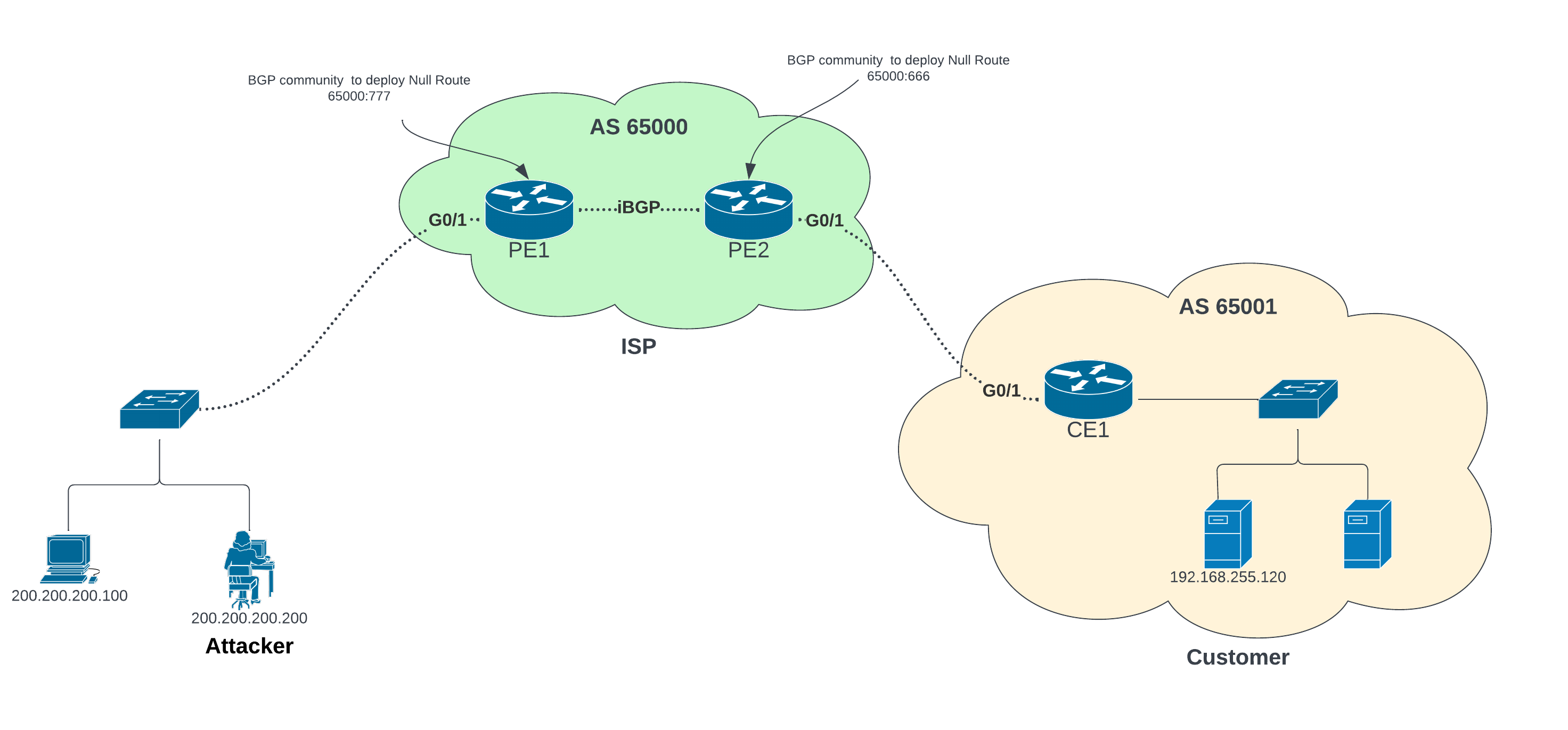
BGP Remote Trigger Blackhole for DDoS
- 5 minsBGP blackholing
Remotely Triggered Black Hole (RTBH) filtering is a self-managed feature that enables you to block unnecessary traffic before it enters your network. RTBH protects you from Distributed Denial of Service (DDoS) attacks.
BGP blackhole filtering is a routing technique used to drop unwanted traffic. Black holes are placed in the parts of a network where unwanted traffic should be dropped. For example, a customer can ask a provider to install black hole on its provider edge (PE) routers to prevent unwanted traffic from entering a customer’s network.
Scope of LAB
In this lab, I am going to setup RTBH between ISP and Customer site. I will configure BGP community to place BGP Null router on specific ISP PE1 or PE2 routers. Customer has choice here to place null route to either device using BGP community.
- To deploy null route on PE1 use BGP community 65000:777
- To deploy null route on PE2 use BGP community 65000:666

PE1
Interface configuration
interface GigabitEthernet0/0
description Link-to-PE2
ip address 10.1.1.1 255.255.255.252
duplex auto
speed auto
media-type rj45
!
interface GigabitEthernet0/1
description Link-to-sw1
ip address 200.200.200.1 255.255.255.0
duplex auto
speed auto
media-type rj45
!
BGP configuration
router bgp 65000
bgp log-neighbor-changes
network 200.200.200.0
neighbor 10.1.1.2 remote-as 65000
neighbor 10.1.1.2 send-community
neighbor 10.1.1.2 route-map customer in
!
Set Null route entry. This is special address which used to set bgp next-hop address of triggered bgp blackhole request.
ip route 192.0.2.1 255.255.255.255 Null0
route-map to match community to install null route in RIB. Deny community in route-map if match to 65000:666
ip bgp-community new-format
ip community-list 10 permit 65000:777
ip community-list 20 permit 65000:666
!
route-map customer deny 5
match community 20
!
route-map customer permit 10
match community 10
set ip next-hop 192.0.2.1
!
route-map customer permit 20
!
PE2
Interface configuration
interface GigabitEthernet0/0
description Link-to-PE1
ip address 10.1.1.2 255.255.255.252
duplex auto
speed auto
media-type rj45
!
interface GigabitEthernet0/1
description Link-to-CE1
ip address 10.0.0.1 255.255.255.252
duplex auto
speed auto
media-type rj45
!
BGP configuration
router bgp 65000
bgp log-neighbor-changes
neighbor 10.0.0.2 remote-as 65001
neighbor 10.0.0.2 ebgp-multihop 255
neighbor 10.0.0.2 route-map customer in
neighbor 10.1.1.1 remote-as 65000
neighbor 10.1.1.1 next-hop-self
neighbor 10.1.1.1 send-community
!
Set Null route entry.
ip route 192.0.2.1 255.255.255.255 Null0
route-map configuration to match community. Install null route in RIB if community match 65000:6666
ip bgp-community new-format
ip community-list 10 permit 65000:666
!
route-map customer permit 10
match community 10
set ip next-hop 192.0.2.1
!
route-map customer permit 20
!
CE1
Interface configurations
interface GigabitEthernet0/0
description Link-to-sw0
ip address 192.168.255.1 255.255.255.0
duplex auto
speed auto
media-type rj45
!
interface GigabitEthernet0/1
description Link-to-ISP-PE2
ip address 10.0.0.2 255.255.255.252
ip flow ingress
duplex auto
speed auto
media-type rj45
!
BGP configurations
router bgp 65001
bgp log-neighbor-changes
network 192.168.255.0
redistribute static route-map RTBH
neighbor 10.0.0.1 remote-as 65000
neighbor 10.0.0.1 send-community
neighbor 192.168.255.10 remote-as 65001
!
route-map configuration to send BGP community using route tag.
route-map RTBH permit 10
match tag 666
set community 65000:666
!
route-map RTBH permit 20
match tag 777
set community 65000:777
!
route-map RTBH permit 30
Validation
Let’s assuming attacker (200.200.200.200) sending DDoS to customer web server (192.168.255.120) and that hogging our internet pipe. Now we will trigger RTBH request to send null route for host 192.168.255.120 from CE1 router. It will send BGP update to install null route on PE1 or PE2 device based on matching community.
CE1(config)#ip route 192.168.255.120 255.255.255.255 Null0 tag 666
Check BGP route on PE2. As you can see entry of 192.168.255.120/32 and Next Hop is 192.0.2.1 which is pointing to Null0 that means attacker traffic will get dropped on PE2 device.
PE2#show ip bgp
Network Next Hop Metric LocPrf Weight Path
*> 192.168.255.0 10.0.0.2 0 0 65001 i
*> 192.168.255.120/32
192.0.2.1 0 0 65001 ?
*>i 200.200.200.0 10.1.1.1 0 100 0 i
Check BGP route on PE1. As per our configuration it doesn’t match BGP community so it’s not going to install null route on PE1.
PE1#show ip bgp
Network Next Hop Metric LocPrf Weight Path
*>i 192.168.255.0 10.1.1.2 0 100 0 65001 i
*> 200.200.200.0 0.0.0.0 0 32768 i
Let’s remove existing null route and replace tag from 666 to 777 and see what happen.
CE1(config)#no ip route 192.168.255.120 255.255.255.255 Null0 tag 666
CE1(config)#ip route 192.168.255.120 255.255.255.255 Null0 tag 777
Check BGP route on PE2. If you notice Next Hop is 10.0.0.2 instead of 192.0.2.1 that means we are not dropping packet on PE2 and continute forwarding.
PE2#show ip bgp
Network Next Hop Metric LocPrf Weight Path
*> 192.168.255.0 10.0.0.2 0 0 65001 i
*> 192.168.255.120/32
10.0.0.2 0 0 65001 ?
*>i 200.200.200.0 10.1.1.1 0 100 0 i
Check BGP route on PE1. Voilla!!! Now you can see route get install in BGP table and Next Hop is 192.0.2.1 which is pointing to Null0.
PE1#show ip bgp
Network Next Hop Metric LocPrf Weight Path
*>i 192.168.255.0 10.1.1.2 0 100 0 65001 i
*>i 192.168.255.120/32
192.0.2.1 0 100 0 65001 ?
*> 200.200.200.0 0.0.0.0 0 32768 i
Using BGP community you can create more controlled way to deploy RTBH on specific entry point of network to stop attacker traffic. In next Blog I will setup Netflow to send DDoS flow to FastNetMon/goBGP tool to detect DDoS and trigger BGP RTBH automatically without any human interaction.
Enjoy!!!